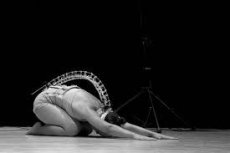Medical expert of the article
New publications
Spinal movements
Last reviewed: 08.07.2025

All iLive content is medically reviewed or fact checked to ensure as much factual accuracy as possible.
We have strict sourcing guidelines and only link to reputable media sites, academic research institutions and, whenever possible, medically peer reviewed studies. Note that the numbers in parentheses ([1], [2], etc.) are clickable links to these studies.
If you feel that any of our content is inaccurate, out-of-date, or otherwise questionable, please select it and press Ctrl + Enter.

Due to the unique arrangement of the two joints - the articulationes inter-vertebrales at the back and the main articulation articulatio intersomatica at the front between the bodies of the vertebrae, movements are possible in all directions, although they are performed unevenly in its various sections.
The range of motion of the spine depends on:
- spatial arrangement of the planes of the joints formed by the processes of the vertebral arches;
- height and elasticity of the intervertebral discs.
The magnitude of the tilt of the vertebral bodies is directly proportional to the square of the height of the intervertebral disc and inversely proportional to the square of the cross-sectional area of the vertebral body.
The height of the intervertebral discs is variable and depends on various factors.
ATTENTION! The height of the intervertebral disc is decisively influenced by the state of the gelatinous (pulpous) nucleus, which in turn depends on the level of fluid content in the nucleus.
The cross-sectional area of the vertebral bodies in numerical terms (in mm2 ) in the cervical, thoracic and lumbar spine is 225:640:784, respectively.
In the cervical spine:
- intervertebral discs are of great height;
- the cross-sectional area of the vertebral bodies is insignificant;
- individual vertebrae have a significant angle of inclination relative to each other;
- advantageous configuration of intervertebral joints;
- large diameter of the spinal canal and intervertebral openings.
All these circumstances provide greater mobility of the cervical spine as in:
- sagittal (flexion and extension);
- frontal (side bends) and in
- horizontal (rotational movements) plane.
In the thoracic spine:
- the ratio of the height of the intervertebral discs to the cross-sectional area of the vertebral bodies is less favorable than in the cervical region;
- the surfaces of the vertebral bodies are flat, not convex, which significantly limits the mobility of the vertebral bodies relative to each other;
- The location of the articular surfaces of the processes of the arches in the frontal plane also makes rotational movements difficult.
In the thoracic spine, only small movements in the sagittal plane (flexion and extension) are possible.
ATTENTION! At the transition point of the thoracic to lumbar spine, the articular processes change their position: their articular surfaces pass from the frontal plane to the sagittal plane.
In the lumbar spine:
- the ratio of the height of the intervertebral discs to the diameter of the vertebral bodies in this section is less favorable than in the thoracic section, which provides a relatively greater range of motion;
- the joints formed by the processes of the arches are located in the sagittal plane; therefore, the greatest range of motion is observed during flexion and extension;
- the amplitude of rotational movements and side bends is not so great.
In the sagittal plane, the amount of flexion and extension of the spine depends on the ratio of the height of the intervertebral disc to the diameter of the vertebral body.
In the frontal plane, the amplitude of lateral tilts depends both on the above-mentioned factors and on the direction of the plane in which the surfaces of the joints formed by the processes of the vertebral arches are located.
Along the vertical axis, the volume of rotational movements depends on the location of the articular surfaces of the processes of the arches.
ATTENTION! Joints whose surfaces are located in a plane that is a segment of a circle provide a large volume of rotational movements.
The direction of movement is limited by the shape of the articular surfaces, and their volume is limited by the joint capsules and ligamentous apparatus.
Flexion is limited by:
- yellow;
- interspinous;
- supraspinous;
- intertransverse ligaments;
- posterior longitudinal ligament;
- posterior semicircle of the fibrous ring.
Extension is limited:
- anterior longitudinal ligament;
- anterior semicircle of the fibrous ring;
- the convergence of the articular, spinous processes and arches.
Side bends are limited:
- longitudinal ligaments (anterior and posterior);
- lateral parts of the fibrous ring;
- yellow ligament (from the convex side);
- intertransverse ligaments;
- joint capsules.
ATTENTION! Side bends are limited in the thoracic region, and also by the ribs.
Rotational movements are limited:
- fibrous ring;
- capsules of intervertebral joints.
Intervertebral disc:
- with ventral flexion, the disc undergoes the greatest deformations in its posterior part, which protrudes significantly into the lumen of the spinal canal;
- with the opposite movement, the disc is deformed in the anterior part, protruding below the anterior longitudinal ligament;
- ventral flexion is accompanied by an increase in the diameter of the intervertebral openings;
- Dorsal flexion reduces the diameter of the intervertebral openings, increasing the pressure on the spinal roots. Therefore, in case of disc prolapses, ventral flexion increases pain, and dorsal flexion reduces it (in case of radicular syndromes, these movements have the opposite effect).


 [
[